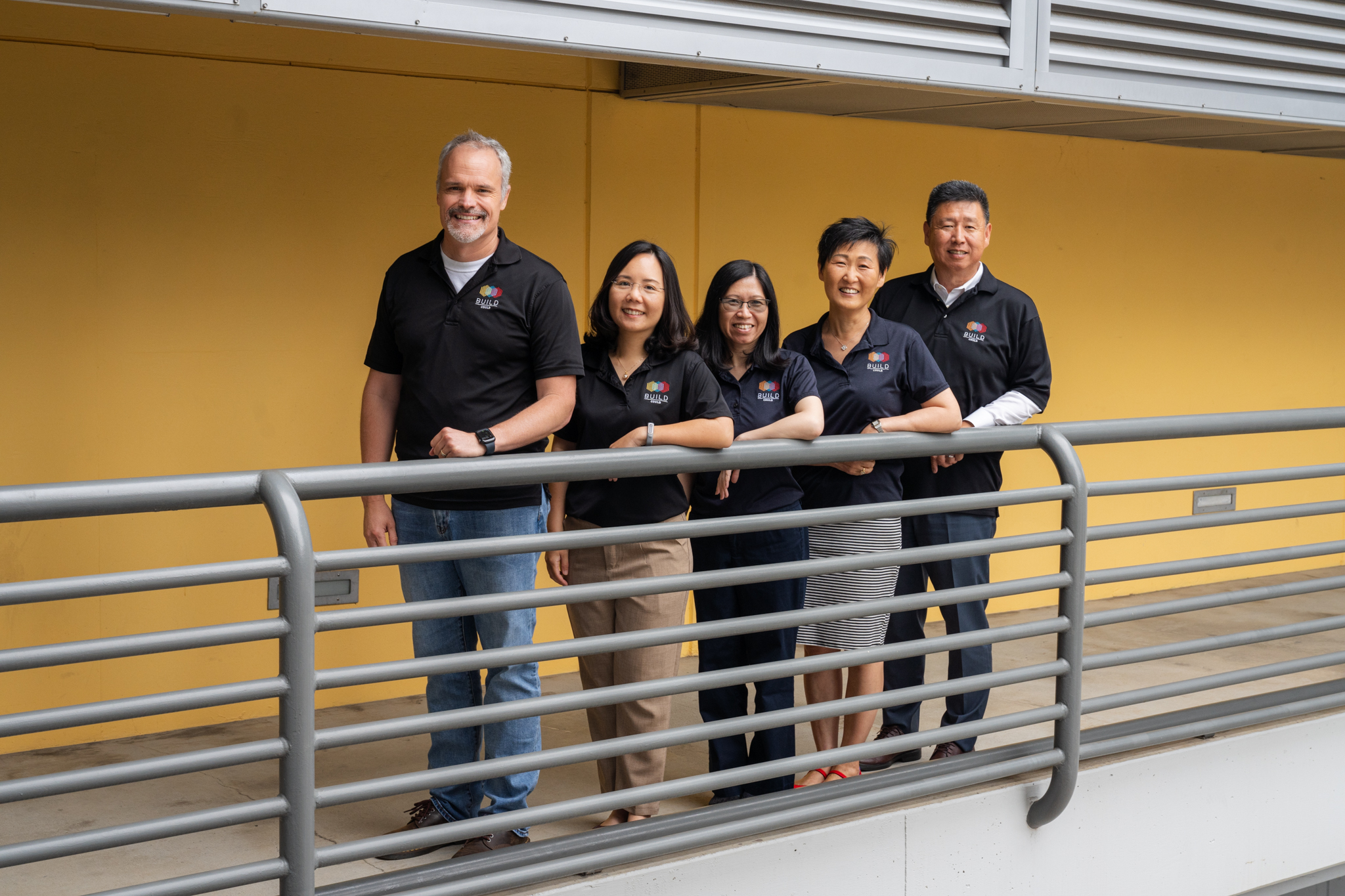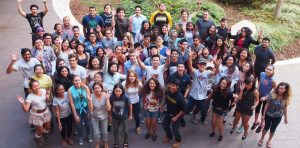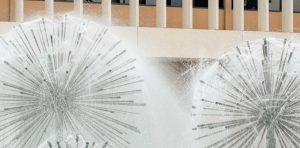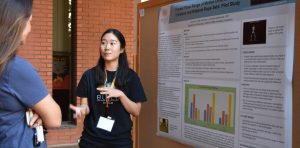
Identity Shift
CROSS-COLLEGE COLLABORATION
After 10 years and $44 million, two BUILD grants result in a fundamentally reshaped CSULB.
Building Infrastructure Leading to Diversity (BUILD) is a grant program from the National Institutes of Health (NIH) and National Institute of General Medical Sciences (NIGMS) that seeks to enhance diversity in the biomedical research workforce by preparing undergraduate students from institutions like California State University, Long Beach for graduate studies. CSULB was awarded two BUILD grants: $24.7 million for phase one (2014 to 2019) and $19.8 million for phase two (2019 to 2024). These are the two largest grants in CSULB history. The phase-two grant has five co-principal investigators: Dr. Chi-Ah Chun, Professor and Chair of the Department of Psychology in the College of Liberal Arts; Dr. Jesse Dillon, Professor and Chair of the Department of Biological Sciences in the College of Natural Sciences and Mathematics; Dr. Panadda (Nim) Marayong, Professor and Associate Chair of the Department of Mechanical and Aerospace Engineering in the College of Engineering; Dr. Kim-Phuong Vu, Professor in the Department of Psychology in the College of Liberal Arts; and Dr. Simon Kim, Associate Vice President in the Office of Research and Economic Development. Phase one was led by Dr. Laura Kingsford, former Dean of the College of Natural Sciences and Mathematics and Dr. Guido Urizar, Professor in the Department of Psychology in the College of Liberal Arts.
The 2015 cohort of BUILD Associates and Scholars kick off a decade-long effort to advance undergraduate research at CSULB.
In describing the BUILD program, Dr. Marayong says, “The way you can think about the NIH support for the BUILD program is that it is a big experiment with each site testing and trying different mechanisms with the goal of increasing the underrepresented students in the health research workforce in the U.S.” One critical aspect of CSULB’s experiment is the university’s commitment to institutionalizing the BUILD program so that it will live on after the university no longer receives grant money. “Very few campuses have committed to extending paid student training beyond the federal funding,” says Dr. Dillon, but CSULB intended to make sure the program was woven into the fabric of the university even before it received the second phase of funding.
Dr. Chun believes that the university’s plan to incorporate the BUILD program into it’s long-term infrastructure is a key reason the program received funding for phase two. “Other BUILD sites are almost envious of the level of institutional support we have received,” she says, adding that the unprecedented support from the institution’s leadership has remained consistent even through several changes at the provost and dean levels.
The BUILD program created research opportunities for undergraduate students in two programs: the two-year Scholars Program and the one-year Fellows Program. Both programs sought to help students pursue postgraduate degrees through a multipronged approach. They were paid to work on research and received faculty mentorship as well as professional development in the form of intensive summer research programs and peer-based learning communities. These programs were combined into a single cohort in summer 2023 as part of the transition to the institutionalized model, and the university expects to support 20 Scholar and Fellow students each year after the end of the BUILD grant. While fewer students will be supported than could be under BUILD’s funding, the program will be more inclusive because it will not be limited to the NIH’s specific guidelines.
The launch of the Office of Undergraduate Research Services (OURS) during BUILD’s first phase is an example of the institutional support that makes CSULB special. Dr. Marayong describes OURS as “a one-stop shop for students who want to explore research opportunities and don’t know where to start.” It was conceived by Dr. Kim as a structure that can allow the institutionalization of BUILD to take place. “The campus aimed to identify strategies to enhance diversity and create a pipeline for undergraduate students. By integrating these practices into OURS, the campus ensures these efforts continue beyond the grant period, fostering an inclusive and supportive environment for future students,” says Dr. Kim.
The OURS Research Certificate Program was created as a way to offer a research training experience similar to what students in the BUILD program receive to more students than the health-focused BUILD program allowed. Students can participate at different levels tailored to their academic and career goals and earn a recognition from OURS. They can learn from professional development modules developed by BUILD on several topics, such as how to apply for graduate school, creating a personal statement, and preparing scholarly publications and presentations. Working with faculty can take many forms as well: volunteering to support a faculty member’s research; being employed on the project through the faculty’s own funding; or receiving credits toward their degree via independent study. The program is open to all undergraduate students, regardless of what they are studying. “This is where we try to broaden access to research for undergraduate students with a model that can be sustained,” says Dr. Marayong.
The BUILD program sought to foster faculty development as well as student training. Dr. Kelly Young, Professor of Biological Sciences, developed the Advancing Inclusive Mentoring program under BUILD, which is now offered as the Beach Mentor Program (BMP) at CSULB. In another example of leadership’s support of the BUILD team’s efforts, Dr. Malcolm Finney, Assistant Vice President of Faculty Affairs and former Director of the Faculty Center, was instrumental in institutionalizing the BMP as an offering for both incoming and existing faculty from the Faculty Center.
The BMP fosters faculty best practices for inclusive and culturally aware mentoring and is so successful it has been adopted at other institutions nationally as well as internationally. Says Dr. Vu, “The program is part of this culture of mentoring, in undergraduate research and aligns very well with the university’s initiatives on expanding access and making the community more inclusive.” Over 300 faculty members have completed this program. Upon completion, they receive both digital and physical badges or pins that they can display. Students can also find mentors who have completed the BMP program in a directory managed by OURS.
BUILD’s goal to enhance diversity in the research workforce is “a multi-level effort,” as Dr. Chun says. “There’s the student training component, there’s a faculty training component, and then there’s the broader effort to change the broader institution, and part of that is to increase the faculty diversity on campus.” Two programs that have been developed as a result of BUILD funding to address faculty diversity are the Faculty Equity Advocates (FEA) program and Pre-Professor Program (PREPP).
BUILD’s phase-two co-principal investigators are, from left, Dr. Jesse Dillon, Professor and Chair of the Department of Biological Sciences; Dr. Panadda (Nim) Marayong, Professor and Associate Chair of the Department of Mechanical and Aerospace Engineering; Dr. Kim-Phuong Vu, Professor in the Department of Psychology; Dr. Chi-Ah Chun, Professor and Chair of the Department of Psychology; and Dr. Simon Kim, Associate Vice President in the Office of Research and Economic Development.
FEA is a program that brings together faculty who work with leadership at the college level to ensure greater diversity among faculty members. Each college administers the program independently according to its needs, but the objective is always to promote the importance of diversity, equity, and inclusion. The FEA program can affect hiring and outreach as well as pedagogy and curriculum.
PREPP started out as a collaboration between the University of California Irvine’s Graduate Division and CSULB’s Provost’s Office and sought to attract doctoral students and postdocs at UC Irvine to become faculty at CSULB. The program assigned participating PhD students or postdocs to faculty liaisons and mentors who showed them what it is like to teach, mentor, and serve as well as conduct research as a faculty member at a comprehensive masters-granting university. The UC Irvine participants were attracted to the faculty life that they saw through PREPP, but CSULB didn’t have the right position open for those applicants. So the program was expanded to include other California State University host campuses. Now, the program is being implemented systemwide under the leadership of Dr. Arturo Zavala, Professor of Psychology, via the Chancellor’s Doctoral Incentive Program with six California State Universities participating with the goal of hiring graduates from PREPP as faculty across the California State University system. To date, eight PREPP fellows have been hired as faculty on a California State University campus.
2023-24 Fellow Ji Hyun (Janice) Ko presents her research poster as part of the BUILD program.
In its 10 years of work, the BUILD program has supported more than 500 CSULB undergraduate trainees working with 109 faculty mentors. But the program’s significance to the university cannot be quantified. In addition to becoming a much more research-focused institution as a whole, CSULB now benefits from increased cross-disciplinary interactions and collaborations. “Originally we were pretty siloed, but it’s been really nice to build this community, to talk to people outside your discipline and engage in the shared mission of undergraduate research training, faculty development, and supporting the university as a whole,” says Dr. Vu. This comprehensive change did not occur by accident; changing the underlying culture or structure of the university was always the goal. “It’s a lot of money—$44 million—but it resulted in a fundamentally different CSULB,” says Dr. Dillon. The impacts may even be more broadly felt than that. “Hopefully, even institutions that aren’t granted that amount of support can utilize some of these tools that we’ve developed and disseminated now so that they can also benefit from what we’ve had, and I think they will,” he says.